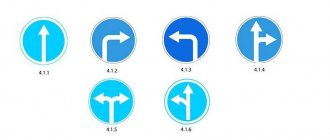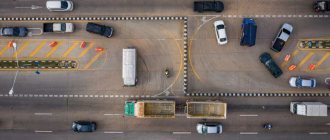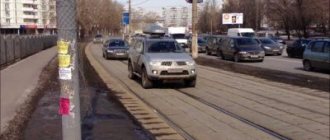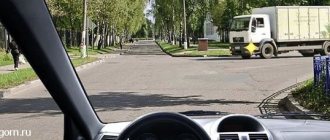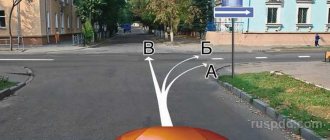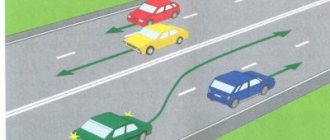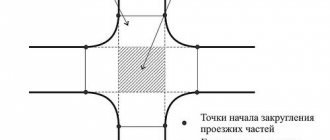What is the penalty for making a U-turn at a pedestrian crossing and when is it prohibited by traffic regulations?
In order to successfully pass the license exam, it is enough to take into account several nuances and follow the learned rules. The main ones regarding turns:
- When turning right/left, you must first take an extreme position on the road, which is intended for movement in that direction. This does not apply to an intersection with a roundabout.
- When turning right, the vehicle should be as close as possible to the right edge of the road.
- If you are making a left turn, you can sometimes move into the lane needed for oncoming traffic, although this is prohibited by the rules in most cases.
- Most often, turning rules are violated in the winter season.
The main reason is the road surface hidden under the snow and the formation of ruts. It should be taken into account that the width of the road is not limited by the knurled section. We must not forget to take the extreme position to perform the maneuver. - You cannot make a U-turn at a zebra crossing: even running into this part of the road can lead to failure of the exam.
- You cannot turn around outside an intersection if there is no visibility of 100 meters or more.
- Be sure to turn on the required direction indicators when performing maneuvers.
Before turning right, left or making a U-turn, the driver is obliged to take in advance the appropriate extreme position on the roadway intended for traffic in this direction, except in cases where a turn is made when entering an intersection where a roundabout is organized. If there are tram tracks in the same direction on the left, located at the same level as the roadway, a left turn and a U-turn must be made from them, unless signs 5.15.1 or 5.15.2 or markings 1.18 prescribe a different movement order. In this case, there should be no interference with the tram.
Thus, before turning, we need to take the extreme left position on the roadway (not only the extreme left lane, but also its left part).
Which trajectory to take to turn is the most important question in this article. There are 2 possible trajectories of movement:
1. Turning at an intersection along a small radius.
2. Large radius turn.
The traffic rules do not describe which specific trajectory should be taken to make a U-turn. But, if we consider a turn as 2 consecutive left turns, then we can choose the best trajectory:
The turn must be carried out in such a way that when leaving the intersection of roadways the vehicle does not end up on the side of oncoming traffic .
In the case of two intersections of roadways, an additional section of road is formed with its own oncoming lane. In this case, travel is only allowed in your own lane, that is, it is logically prohibited in the oncoming lane. When passing through such an intersection, a U-turn can only be made along the path shown in green. That is, go to a further perpendicular lane, and then return from it to the lane in the opposite direction.
You can make a U-turn at an intersection along two trajectories – near and far. When choosing a trajectory, you need to focus on the place where your car will go after completing the maneuver. The presence of a dividing strip requires the use of a long-range trajectory. If there is none, you have the right to choose your own trajectory.
- A long-distance turn is appropriate if the driver cannot make the turn directly near the end of the dividing line. There may be several reasons: the car is too long, the roadway is too narrow, a large vehicle has blocked part of the road, repair work is underway. If it is not possible to turn around from a standstill, you can drive a little forward and go into an arc so as to get additional space to align the car and fit it into a row. You can arbitrarily choose the distance before the start of the maneuver; it is even permissible to turn directly near the edge of the roadside, zebra crossing, strip or opposite dividing line.
- A short trajectory when turning is appropriate if there is enough space on the road surface for maneuver and there is no need to form an arc. In this case, the turn is made at the very beginning of the road intersection, directly at the edge of the continuous road into the oncoming lane. The driver is obliged to calculate in advance the likelihood of the car driving onto the curb, since this will already create an emergency situation. It is also necessary to ensure that the car does not drive over zebra crossings or solid ones.
The turn along the trajectory should be carried out so that the vehicle does not go beyond the intersection of roadways. You can choose any traffic pattern, but ensure compliance with traffic rules. How to turn around correctly at an intersection with a traffic light, dividing strip, one-way traffic, tram tracks and other features?
If the adjacent territory is on the right, the algorithm of actions is as follows.
- Drive forward, but do not press close to the curb.
- You must stop a meter from the turn into the adjacent territory; be guided by the dimensions of the vehicle.
- Make sure there are no obstructions on the roadway (vehicles and pedestrians).
- Turn on the right turn signal and start driving in reverse, turning the corner.
- Stop as soon as the bumper of your car disappears into the turn and does not interfere with the movement of other cars.
- Turn on the right turn signal and wait until there is a gap in the traffic flow. Then you can drive onto the roadway.
If the surrounding area is on the left, your actions are as follows.
- Stop once you are in the far left lane and turn on your left turn signal.
- Give way to oncoming cars and start moving ahead towards the adjacent territory. Keep to the right.
- As soon as you turn off the roadway, check to see if there are any cars behind you.
- Carefully reverse onto the roadway and continue driving.
If the dividing strip does not reach the intersection, you need to turn around along a small trajectory; there will be enough space. If the dividing line crosses an intersection, the turning radius must be large, otherwise you will have to move in the oncoming lane for some time, and for this you may lose your license. Don't forget to take into account the width of the dividing strip.
Traffic regulations regulate the advantage of rail transport over other vehicles in most cases. A tram must give way to a car if the car is moving on the main road and the tram is moving on an adjacent road. The tram is a priority if there is a traffic light at the intersection that allows both cars and trams to move.
If the traffic light is red for a tram and green for a car, the driver of the car acts in accordance with the traffic rules. However, at this moment the traffic switch may light up, and the tram driver decides to go. Consequently, it is better to always give way to the tram, since it is not always possible to predict whether the driver is guided by a traffic light or an arrow. A U-turn at an uncontrolled intersection with tram tracks requires you to always let the tram pass, except in situations where the car is traveling on the main road.
